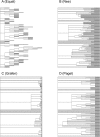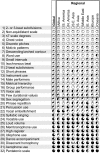Statistical universals reveal the structures and functions of human music
- PMID: 26124105
- PMCID: PMC4517223
- DOI: 10.1073/pnas.1414495112
Statistical universals reveal the structures and functions of human music
Abstract
Music has been called "the universal language of mankind." Although contemporary theories of music evolution often invoke various musical universals, the existence of such universals has been disputed for decades and has never been empirically demonstrated. Here we combine a music-classification scheme with statistical analyses, including phylogenetic comparative methods, to examine a well-sampled global set of 304 music recordings. Our analyses reveal no absolute universals but strong support for many statistical universals that are consistent across all nine geographic regions sampled. These universals include 18 musical features that are common individually as well as a network of 10 features that are commonly associated with one another. They span not only features related to pitch and rhythm that are often cited as putative universals but also rarely cited domains including performance style and social context. These cross-cultural structural regularities of human music may relate to roles in facilitating group coordination and cohesion, as exemplified by the universal tendency to sing, play percussion instruments, and dance to simple, repetitive music in groups. Our findings highlight the need for scientists studying music evolution to expand the range of musical cultures and musical features under consideration. The statistical universals we identified represent important candidates for future investigation.
Keywords: cross-cultural universals; cultural phylogenetics; ethnomusicology; evolution; group coordination.
Conflict of interest statement
The authors declare no conflict of interest.
Figures







Comment in
-
Cross-cultural convergence of musical features.Proc Natl Acad Sci U S A. 2015 Jul 21;112(29):8809-10. doi: 10.1073/pnas.1510724112. Epub 2015 Jul 8. Proc Natl Acad Sci U S A. 2015. PMID: 26157132 Free PMC article. No abstract available.
References
-
- Pagel M, Mace R. The cultural wealth of nations. Nature. 2004;428(6980):275–278. - PubMed
-
- Brown DE. Human Universals. Temple Univ Press; Philadelphia: 1991.
-
- Barkow JH, Cosmides L, Tooby J, editors. The Adapted Mind: Evolutionary Psychology and the Generation of Culture. Oxford Univ Press; New York: 1992.
-
- Shepard RN. Perceptual-cognitive universals as reflections of the world. Psychon Bull Rev. 1994;1(1):2–28. - PubMed
-
- Longfellow HW. Outre-mer: A Pilgrimage Beyond the Sea. Harper; New York: 1835.
Publication types
MeSH terms
LinkOut - more resources
Full Text Sources
Other Literature Sources
Medical
Miscellaneous

